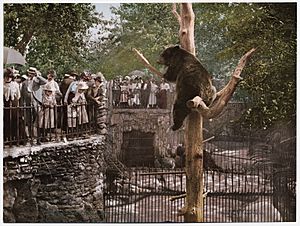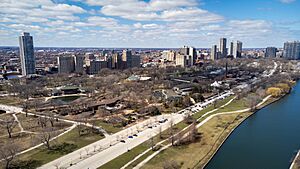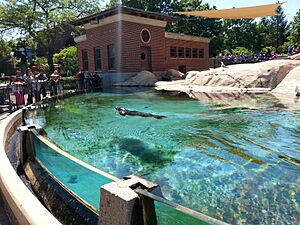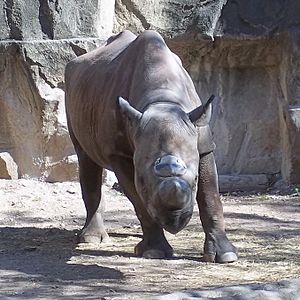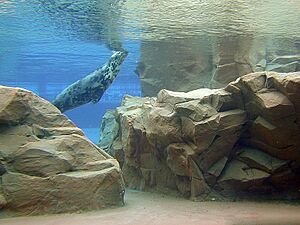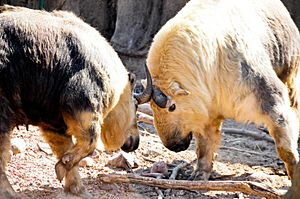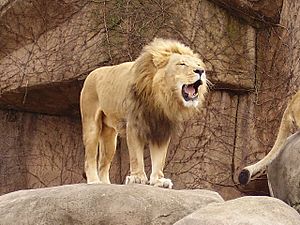Lincoln Park Zoo facts for kids
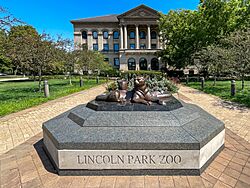
Zoo administration building
|
|
| Date opened | 1868 |
|---|---|
| Location | 2204 N. Cannon Drive, Chicago, Illinois, United States |
| Land area | 35 acres (14 ha) |
| Coordinates | 41°55′17″N 87°38′02″W / 41.92139°N 87.63389°W |
| No. of animals | 1,100 |
| No. of species | 200 |
| Annual visitors | 3.42 million |
| Memberships | AZA |
| Major exhibits | Farm-in-the-Zoo, Helen Brach Primate House, Pepper Family Wildlife Center, Kovler Seal Pool, McCormick Bird House, Nature Boardwalk, Pritzker Family Children's Zoo, Regenstein African Journey, Regenstein Center for African Apes, Regenstein Small Mammal-Reptile House |
The Lincoln Park Zoo is a fun place to visit in Chicago, Illinois. It is a 35-acre zoo located in Lincoln Park. The zoo first opened in 1868. This makes it the second oldest zoo in the United States. It is also one of the few zoos that you can visit for free!
The Lincoln Park Zoo is a special place for animals. It has about 1,100 animals from 200 different kinds of species. You can see big cats, polar bears, penguins, gorillas, reptiles, and monkeys here. The zoo is also a member of the Association of Zoos and Aquariums (AZA). This means it meets high standards for animal care. In 2019, it also became an accredited arboretum, which means it's a special place for trees and plants.
For a long time, the zoo was home to a very old burr oak tree. Experts thought it was more than 250 years old! Sadly, the tree was cut down on May 2, 2023, because it was not healthy. But don't worry, 36 new trees were started from parts of the old tree. They are now growing at the Morton Arboretum.
Contents
- History of the Zoo
- Zoo Exhibits
- Walter Family Arctic Tundra
- Robert and Mayari Pritzker Penguin Cove
- Regenstein Macaque Forest
- Regenstein African Journey
- Regenstein Center for African Apes
- Pritzker Family Children's Zoo
- Kovler Seal Pool
- Regenstein Small Mammal-Reptile House
- Regenstein Birds of Prey Exhibit
- Helen Brach Primate House
- McCormick Bird House
- Camel & Zebra Area
- Waterfowl Lagoon
- Hope B. McCormick Swan Pond
- Farm-in-the-Zoo
- Pepper Family Wildlife Center
- Former Exhibits
- Images for kids
- See also
History of the Zoo
The zoo started in 1868 with a gift. The Lincoln Park Commissioners received two pairs of swans from Central Park in New York City. Soon, more animals were given to the park. These included a puma, elk, wolves, eagles, and peacocks.
In 1874, the zoo bought its first animal. It was a bear cub from the Philadelphia Zoo. This bear was very good at escaping! It often roamed Lincoln Park at night. In 1884, an American bison was born at the zoo. This was believed to be the first bison born in captivity. At that time, bison were almost gone in the wild. In 1896, the U.S. government bought bison from the zoo. They sent them to Yellowstone National Park to help bring the species back.
From 1888 to 1919, Cy DeVry was the zoo's director. He helped collect animals and built many new buildings. He also got the zoo's first elephant and monkeys. A new Lion House opened in 1912. It was updated and reopened in 1990. The Primate House opened in 1927. It was famous for a gorilla named Bushman (1931–1951). Bushman was one of the few gorillas in a U.S. zoo then.
The zoo's great apes moved to the Lester E. Fisher Great Ape House in 1976. The old Primate House was updated. It reopened in 1992 as the Helen Brach Primate House. This new house had more natural-looking homes for the animals.
Marlin Perkins was the zoo's director from 1944 to 1962. He was famous for hosting TV shows like Zoo Parade and Wild Kingdom. He started a group called the Lincoln Park Zoological Society. This group helped support the zoo. The zoo changed a lot in the 1970s and 1980s. Many new, natural-looking exhibits were added. In 1995, the Zoological Society took over running the zoo.
The Kovler Sea Lion Pool was updated and reopened in 1999. It is now home to the zoo's harbor seals.
The Regenstein African Journey opened in 2003. This exhibit used to be the Large Mammal House. It became a place to show the wildlife of Africa. It brought back African elephants and giraffes. New animals like the aardvark, ostrich, and African wild dog also joined. Two years later, the Great Ape House was updated. It became the Regenstein Center for African Apes in 2005. This center focuses on common chimpanzees and western lowland gorillas. It helps research their behavior and gives them natural homes.
In 2010, the zoo changed the nearby South Pond. It became the Nature Boardwalk. This is a natural area with wetlands plants and wildlife.
In December 2011, the Kovler Penguin-Seabird House closed. It had been open for 30 years. It closed because the building was getting old. This made some Chicago residents upset. The zoo later announced a new exhibit would replace it. This new exhibit, Regenstein Macaque Forest, opened in fall 2014. It features Japanese macaques, also known as "snow monkeys." It even has a hot spring for them!
In March 2014, the zoo announced more changes. The Robert R. McCormick Bear Habitat would be rebuilt. It would have a much bigger home for the zoo's polar bear. This new home would have more land and a special den for breeding. The new exhibit would also have a home for African penguins. These penguins are new to the zoo. They can live in both hot summers and cold winters. This exhibit, Robert and Mayari Pritzker Penguin Cove, opened in late 2016.
In 2016, the zoo started a fundraising campaign called "Pride of Chicago." This campaign helped build Regenstein Macaque Forest, Robert and Mayari Pritzker Penguin Cove, and Walter Family Arctic Tundra. It also led to a big update of the Kovler Lion House. This update cost $30 million. The new exhibit opened in late 2021. It focuses on lions.
Zoo Programs
The zoo works with the Adler Planetarium to study Chicago's wildlife. They use a website called Zooniverse. The zoo puts cameras around Chicago to take pictures of animals. People can then help identify the animals in the pictures.
The zoo also has many programs for young people. These include camps and school field trips. They also have programs for communities like Little Village and North Lawndale. These programs help create green spaces in Chicago. They also teach about healthy eating.
During the COVID-19 pandemic, the zoo moved many programs online. For example, their Artecito program connected families with nature through art.
Zoo Exhibits
The zoo has almost 1,100 animals in its collection.
Walter Family Arctic Tundra
This exhibit used to be the Robert R. McCormick Bear Habitat. It is now a new home for the zoo's polar bears. It is much larger than the old habitat. It has natural grass, a new underwater viewing area, and a special den for baby bears. It is big enough for a small family of bears.
Robert and Mayari Pritzker Penguin Cove
This is a new outdoor home for African penguins. Visitors can watch these penguins dive into the water. There is also a special area behind the scenes for hatching chicks. The zoo offers indoor Penguin Encounters too. This exhibit opened in October 2016.
Regenstein Macaque Forest
Opened in 2014, Macaque Forest lets visitors see a group of 10–15 Japanese macaques. It looks like a hidden forest. You can see the animals from above and at eye-level. The exhibit has a "hot spring," which these monkeys love. It helps them stay warm in winter. This area is also a research station for the macaques.
Regenstein African Journey
The Regenstein African Journey is a large indoor and outdoor exhibit. It opened in May 2003. It shows four different habitats from Africa. Large skylights let in natural light. When you enter, you see monkeys in a rainforest setting. The next part shows African rivers. It has big glass panels to see West African dwarf crocodiles and pygmy hippos. There is also a large Lake Malawi cichlid tank.
The third section is like the African savanna. It has homes for meerkats, aardvarks, and giraffes. The last section looks like African kopje habitats. Here you can see klipspringer antelopes.
Outside, there is a large African savanna area. It mainly houses the zoo's giraffes. There is also a big yard for African painted dogs. Another yard is for red river hogs. There are also yards for the zoo's black rhinos.
The exhibit was once home to three African bush elephants. Sadly, all three died within two years. The exhibit later held Bactrian camels. Now, it is an extra home for the zoo's rhinos.
Mammals
- Aardvark
- African wild dog
- Diana monkey
- Eastern black rhinoceros
- Giraffe
- Klipspringer
- Meerkat
- Plains zebra
- Pygmy hippopotamus
- Red river hog
Reptiles
Birds
- African spoonbill
- Abdim's stork
- Blue-bellied roller
- Blue-billed teal
- Crested guineafowl
- Hadada ibis
- Northern red-billed hornbill
Invertebrates
- Golden silk spider
- Madagascar hissing cockroach
Regenstein Center for African Apes
The Lincoln Park Zoo loves to study primates. The Lester E. Fisher Great Ape House was rebuilt. It became the Regenstein Center for African Apes in 2005. This new center focuses on chimpanzees and western lowland gorillas. It has over 29,000 square feet of indoor and outdoor space. It has many trees, fake vines, and bamboo. There are also skylights, waterfalls, and heated logs. The chimpanzees can even "fish" for termites in fake termite mounds.
The exhibit has three large habitats. The Kovler Gorilla Bamboo Forest is 12,000 square feet. It is an open-air home for the zoo's main gorilla group. Two other exhibits can hold either chimpanzees or gorillas. They have mesh netting to keep the animals safe. Huge glass panels let you see the apes up close. The exhibit also has a research center. It helps guests learn about ape conservation.
Some famous residents include Kwan, a gorilla who was in a movie. There's also a chimpanzee named Optimus Prime.
Pritzker Family Children's Zoo
The Pritzker Family Children's Zoo opened in 2004. It shows many animals native to eastern America. It helps visitors connect with local wildlife. You can learn how animals survive in the wild. Small amphibians and reptiles are in an indoor exhibit. There is also a fun leaf-themed play area for kids.
Larger indoor exhibits feature birds and reptiles. Big glass windows let you watch American beavers and North American river otters. You can see them swim underwater! Educational displays teach about how beavers build dams. Outside, many local birds build nests.
Two larger outdoor exhibits are for the American black bear and the endangered red wolf. These areas have lots of plants and a natural stream. You can see the animals up close. Statues of gray wolves and signs teach about wolf packs.
Mammals
Reptiles
- Blanding's turtle
- Ornate box turtle
- Spotted turtle
- Three-toed box turtle
- Wood turtle
Birds
Kovler Seal Pool
The Kovler Seal Pool is one of the zoo's oldest and most popular exhibits. It first opened in 1879. It was most recently updated in May 1999. The goal was to make it look more like the seals' natural home.
You can view the seals from three places. There's a fence in front of the tank. There's also an amphitheater-style seating area above the tank. And there's an underwater viewing area! You can watch the seals glide through the water. The zoo's seals are trained twice a day. They get fish treats as rewards. Since May 2013, only gray and harbor seals live here.
Regenstein Small Mammal-Reptile House
The Regenstein Small Mammal-Reptile House is a 32,000-square-foot indoor exhibit. It opened in 1997. It has small animals in two main areas: the Gallery and the Ecosystem. The Gallery has many terrariums with reptiles and amphibians. It also has small mammals living around a fake baobab tree trunk.
The Ecosystem is a 45-foot tall geodesic dome. It looks like the world's tropical rainforests. It has stream exhibits for caimans and otters. It also has exhibits for tree-dwelling animals like primates.
Mammals
- Asian small-clawed otter
- Brush-tailed bettong
- Cactus mouse
- Common dwarf mongoose
- Egyptian fruit bat
- Hoffmann's two-toed sloth
- Mohol bushbaby
- Naked mole-rat
- Northern treeshrew
- Prehensile-tailed porcupine
- Pygmy slow loris
- Southern three-banded armadillo
- White-faced saki
Reptiles
- African rock python
- Aruba island rattlesnake
- Black tree monitor
- Eastern massasauga
- Green tree python
- Iranian fat-tailed gecko
- Jamaican iguana
- Northern blue-tongued skink
- Oriente knight anole
- Prehensile-tailed skink
- Red-footed tortoise
- Rio Fuerte beaded lizard
- Spectacled caiman
- Virginia islands boa
- West African Gaboon viper
- Yellow-spotted river turtle
Amphibians
- Amazon milk frog
- Anthony's poison dart frog
- Axolotl
- Dyeing poison dart frog
- Emperor newt
- Oriental fire-bellied toad
- Solomon Islands leaf frog
Fish
Birds
Invertebrates
- Carlsbad green tarantula
- Common walkingstick
Regenstein Birds of Prey Exhibit
This outdoor exhibit is near the McCormick Bird House. It lets visitors see powerful birds-of-prey. The aviaries are stunning and give the birds lots of room. They can spread their wings or perch on rocks and branches. These exhibits show how birds-of-prey help clean up nature. One large habitat has multiple birds, including breeding pairs of cinereous vultures and white storks. Two other aviaries have the zoo's bald eagle and a snowy owl.
Helen Brach Primate House
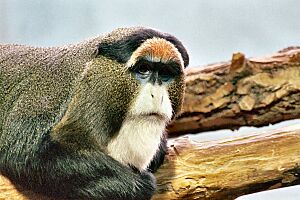
The zoo's old Primate House opened in 1927. It had apes and monkeys in small, barred cages. It became famous for its apes, like Bushman the gorilla. The Primate House was updated in the early 1990s. It reopened as the Helen Brach Primate House in 1992. It now has eight natural-looking exhibits. These exhibits look like the swamps and rainforests where the animals live. A family of white-cheeked gibbons lives here. They have a big indoor room and an outdoor area for warm weather.
Crowned lemurs joined the exhibit in October 2013. A baby lemur was born at the zoo on April 14, 2014.
McCormick Bird House
The McCormick Bird House is one of the zoo's oldest buildings. It was first designed in 1904. It has been updated many times, most recently in 1991. It now has many habitats that look like different places. These include tropics, savanna, sea shore, desert, and wetlands. There is a tropical free-flight aviary. Here, guests can walk among perching and water birds without fences. Some famous birds include the laughing kookaburra and scarlet ibis. The zoo also breeds the Bali myna, a critically endangered bird.
- Abdim's stork
- American avocet
- Baer's pochard
- Bali myna
- Black-necked stilt
- Blue-crowned laughingthrush
- Blue-crowned motmot
- Blue-faced honeyeater
- Blue-grey tanager
- Bourke's parrot
- Chinese hwamei
- Collared finchbill
- Crested wood partridge
- Emerald starling
- Golden-breasted starling
- Green broadbill
- Guam kingfisher
- Guam rail
- Guira cuckoo
- Hamerkop
- Helmeted curassow
- Inca tern
- Jambu fruit dove
- Kagu
- Laughing kookaburra
- Luzon bleeding-heart
- Mandarin duck
- Masked lapwing
- Nicobar pigeon
- Red-billed leiothrix
- Red-capped cardinal
- Scarlet ibis
- Snowy-crowned robin-chat
- Snowy egret
- Spotted thick-knee
- Sunbittern
- Taveta weaver
- Tawny frogmouth
- Violet turaco
- White-headed buffalo weaver
- White-rumped shama
Camel & Zebra Area
The zoo's 2.5-acre Camel & Zebra Area was built in 1982. It is on the south end of the zoo. It has large grassland exhibits for the zoo's hoofstock and other animals. This area has held many species over the years. The most recent additions are the waterbuck from Africa and the endangered Sichuan takin.
The zoo has had success breeding the Sichuan takin. Two baby takin were born in January and February 2013. They were named Xing Fu and Mengyao. A baby kangaroo was born on December 9, 2013. It was later named Jack.
Waterfowl Lagoon
This lagoon is home to the zoo's flock of almost 50 Chilean flamingos. They use the mudflaps in the exhibit to build nests. In winter, they use the indoor Flamingo Habitat to stay warm. It is also home to swan geese.
Hope B. McCormick Swan Pond
The Lincoln Park Zoo started with a gift of swans. To remember this, a pair of trumpeter swans still live at the zoo. They are in the Hope B. McCormick Swan Pond. This pond is a reminder of the zoo's long history. Many different kinds of waterfowl also live here.
Farm-in-the-Zoo
The Farm-in-the-Zoo is across the South Pond from the main zoo. It is designed to let Chicago kids experience farm life. It opened in 1964. It has pigs, cows, horses, and other farm animals. Visitors can pet and feed the animals. They can also explore vegetable gardens. Every day, the cows are milked in public. Staff are there to explain farm life. Interactive exhibits let guests learn about farm weather and gardening.
Pepper Family Wildlife Center
The Kovler Lion House is a historic building. It was first built in 1912. It is at the heart of the zoo. It has housed many different big cat species over the years. This includes lions and Siberian tigers. These animals had indoor areas and glass windows for visitors to see them. Other big cats, like the jaguar, also lived here. The southern part of the building had five lush habitats. These housed different cat species. It also had red pandas.
Many species lived in the southern habitats over the years. These included Amur leopards, Eurasian lynxes, and a Pallas's cat. A puma also lived there later. A one-year-old snow leopard named Taza arrived on December 11, 2014.
Adelor the African lion was a famous resident. He lived at the zoo from 1995 until his death in February 2012. He was one of the zoo's most popular animals. A statue of Adelor now stands at the East Gate. He was followed by a male lion named Sahar.
In 2016, the zoo announced a $30 million update for the habitat. This was part of the "Pride of Chicago" campaign. The new exhibit focuses on African lions. It also has spaces for Canada lynx, Snow leopards, and red pandas. The exhibit closed in 2019 for the update. It reopened as the Pepper Family Wildlife Center in the fall of 2021.
On March 15/16, 2022, a male lion cub was born. His name is Pilipili, which means Pepper in Swahili language. He is the first lion cub born at the zoo in 20 years. Three more lion cubs were born on January 9, 2023. This brought the total number of lions to eight.
Former Exhibits
Bear Habitat
The Robert R. McCormick Bear Habitat, or "Bear Line," was next to Regenstein African Journey. It housed many carnivores over the years. It had natural-looking exhibits with trees, waterfalls, and climbing structures. These were for bears and wolves. At the north end was a large polar bear pool. It had an underwater window. The zoo received two polar bears, Lee and Anana, in 2001. Only Anana remained, as Lee moved to another zoo for breeding. The only other animal left was a single Malayan sun bear. The exhibit also used to have two elderly spectacled bears. The spotted hyenas also moved to another zoo. The maned wolf and Mexican wolf were moved when the Pritzker Family Children's Zoo opened its red wolf habitat in 2005.
This exhibit closed in winter 2014. Work began on the new polar bear and penguin habitats on the same site. The new habitat reopened in late 2016.
Penguin-Seabird Exhibit
The zoo's old Aquatic Bird House opened in 1981/1982. It had two main viewing areas. The first had three kinds of penguins: rockhopper, chinstrap, and king penguins. They lived in a large, temperature-controlled pool. The air and water were kept chilly. A computer system copied the natural daylight cycle for penguins. The second area had tufted puffins, common murres, and razorbills. They swam in a pool that looked like the North Atlantic coast. The birds made their homes on rocky cliffs. This historic building closed on December 5, 2011. It was replaced with Regenstein Macaque Forest. The 66 birds from this exhibit moved to 11 other zoos and aquariums. A new African penguin habitat was built nearby. It opened in 2016.
Images for kids
-
The trumpeter swans were the first gifts that founded the zoo and still present at the zoo.
-
Blyth's hornbill (Rhyticeros plicatus)
-
Siberian tiger at the zoo
-
Concert at the zoo on Earth Day
-
Bactrian camels (Camelus bactrianus)
See also


